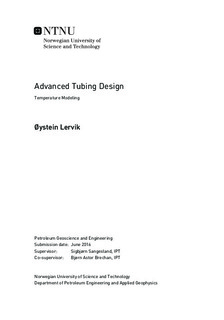Advanced Tubing Design - Temperature Modeling
Master thesis
Permanent lenke
http://hdl.handle.net/11250/2445598Utgivelsesdato
2016Metadata
Vis full innførselSamlinger
Sammendrag
In casing and tubing design, one of the most important aspects is to make the well safe for operation. This includes many complex areas that need thorough understanding, with one being temperature prediction. This is a vital skill to be able to do correctly, especially in high-pressure, high-temperature (HPHT) wells. A great understanding of the mathematics involved is needed to predict wellbore temperatures with high precision.
The mathematics involved in temperature prediction and some of the most important production loads were investigated in this thesis. A model was established in Matlab based on literature on the subject, and the results from the model were compared to results from industry leading software (ILS). A sensitivity analysis of the model was done, by analyzing the sensitivity of some of the parameters.
The effect of neglecting convection from the model was tested. When neglecting convection, there was a high difference in the simulated temperatures. Including the Joule-Thomson effect in the model was also tested. The inclusion showed that for certain values of a correction factor for the Joule-Thomson effect, the simulated fluid temperature were very close to the ILS temperature.
The model can be improved. Implementation of vertical heat transfer into the model, can give a more realistic wellbore heat transfer simulation, and can give more precise predicted temperatures. In addition to this, the results can be compared to data from existing wells, to give less uncertainty from the model.
